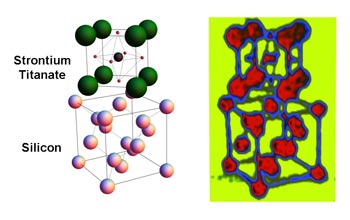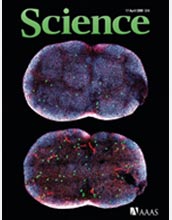All Images
News Release 09-074
"Instant On" Computing
Materials researchers say rebooting soon may be a thing of the past
This material is available primarily for archival purposes. Telephone numbers or other contact information may be out of date; please see current contact information at media contacts.

Researchers report matching the spacing of silicon atoms--the principal component of computer semiconductors--and the spacing of atoms in a material called strontium titanate--a normally non-ferroelectric variant of a material used in "instant memory smart cards." The matched spacing allows the silicon to squeeze the strontium titanate in such a way that it produces ferroelectric properities. Ferroelectric materials provide low-power, high-efficiency electronic memory for devices such as "smart cards" that can instantly reveal and update stored information when waved before a reader. When applied to computer transistors, these materials could allow "instant-on" capability, eliminating the time-consuming booting and rebooting of computer operating systems.
Credit: Jeremy Levy, University of Pittsburgh
Download the high-resolution JPG version of the image. (164 KB)
Use your mouse to right-click (Mac users may need to Ctrl-click) the link above and choose the option that will save the file or target to your computer.

The researchers' findings are published in the April 17, 2009, issue of Science magazine.
Credit: Copyright 2009 AAAS
Download the high-resolution JPG version of the image. (41 KB)
Use your mouse to right-click (Mac users may need to Ctrl-click) the link above and choose the option that will save the file or target to your computer.


